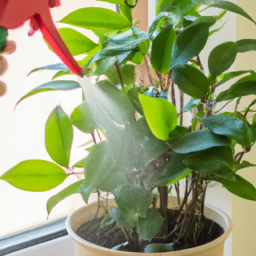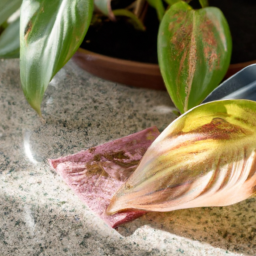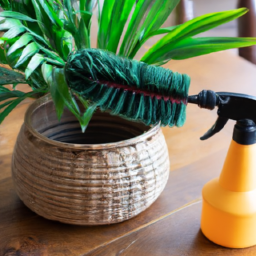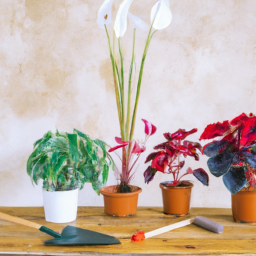
Hey there, plant enthusiasts! Summer is finally here, and with it comes the scorching heat that can take a toll on our beloved green friends. But fear not, because in this blog post, we’ll be delving into the world of summer plant care and discovering ways to beat the heat with tender loving care, or TLC for short. Whether you’re a seasoned gardener or a newbie plant parent, these tips and tricks will ensure that your leafy companions thrive throughout the hottest months of the year. So grab a cold drink, find a shady spot, and let’s dive into the wonderful world of summer plant care!
Importance of Watering Techniques for Summer Plant Care
Summertime can be a challenging season for plants as the scorching heat and intense sunlight can take a toll on their health. The key to ensuring your plants thrive during this time is to provide them with proper care and attention, especially when it comes to watering. In this guide, we will explore the importance of watering techniques for summer plant care and provide you with a step-by-step approach to keep your plants hydrated and happy.
Understanding the Water Needs of Your Plants
Before we delve into watering techniques, it’s crucial to understand the water needs of different plants. Each plant has its own unique requirements, and it’s essential to tailor your watering approach accordingly. Factors such as plant species, size, age, and soil type play a significant role in determining how much water a plant needs.
One way to assess the water needs of your plants is to check the moisture level of the soil. Stick your finger about an inch into the soil and feel if it’s dry or moist. If it feels dry, it’s an indication that your plant needs watering. On the other hand, if the soil feels moist, it’s best to hold off watering until it dries out a bit.
It’s important to note that overwatering can be just as harmful as underwatering. Excess water can lead to root rot and other fungal diseases, depriving the plant of oxygen. Therefore, it’s crucial to strike a balance and provide just the right amount of water.
Choosing the Right Watering Techniques
Now that we understand the importance of watering, let’s explore some effective techniques to keep your plants hydrated during the summer months.
1. Deep Watering: Shallow watering only wets the surface of the soil, resulting in shallow root growth. To encourage deep root growth, water your plants deeply and less frequently. This allows the water to penetrate the soil and reach the roots, promoting stronger and healthier plants.
2. Watering in the Morning: It’s best to water your plants early in the morning when the temperature is cooler. This gives the plants ample time to absorb the moisture before the heat of the day sets in. Watering in the evening can lead to prolonged moisture on the foliage, making the plants susceptible to diseases.
3. Mulching: Mulching is an effective technique to conserve moisture in the soil and reduce evaporation. Apply a layer of organic mulch, such as wood chips or straw, around the base of your plants. This helps to keep the soil cool, suppresses weed growth, and retains moisture, reducing the frequency of watering.
4. Drip Irrigation: Drip irrigation is a water-efficient method that delivers water directly to the plant’s root zone. This technique minimizes water loss due to evaporation and ensures that the water reaches the roots where it’s needed the most. It also helps to prevent waterlogging and encourages deep root growth.
Monitoring and Adjusting Your Watering Routine
While following these watering techniques is essential, it’s equally important to monitor your plants and adjust your watering routine as needed. Keep an eye on the weather conditions, as rainfall can affect the watering requirements of your plants. During periods of heavy rain, you may need to reduce or even pause your watering schedule.
Regularly inspect your plants for any signs of distress or dehydration. Wilting, yellowing leaves, and dry soil are indications that your plants need more water. On the other hand, if you notice waterlogged soil or fungal growth, it’s a sign of overwatering, and you should adjust your watering frequency accordingly.
Remember to also consider the specific needs of potted plants. Containers tend to dry out more quickly than the ground, so they may require more frequent watering. Additionally, plants in hanging baskets or elevated areas may be exposed to more heat and wind, necessitating extra care and attention.
By understanding the water needs of your plants, choosing the right watering techniques, and monitoring their condition, you can ensure that your plants stay healthy and vibrant throughout the summer season. Remember, a little bit of TLC goes a long way in beating the heat and keeping your plants happy!

Summer Plant Care: Beating the Heat with TLC
2. Choosing Heat-Tolerant Plants for Summer Gardens
When it comes to maintaining a beautiful garden during the scorching summer months, choosing heat-tolerant plants is essential. These plants have adapted to withstand high temperatures and can thrive in the hot and dry conditions that summer brings. By selecting the right plants for your summer garden, you can ensure that your plants not only survive but also flourish. In this guide, we will walk you through the process of choosing the perfect heat-tolerant plants for your summer garden.
Understanding Heat-Tolerant Plants
Heat-tolerant plants are those that have evolved to survive and thrive in hot climates. These plants have certain characteristics that enable them to withstand high temperatures, such as deep root systems that allow them to access water from lower soil layers, or waxy leaves that reduce water loss through evaporation. By understanding these characteristics, you can make informed choices when selecting plants for your summer garden.
One important factor to consider when choosing heat-tolerant plants is their ability to handle drought conditions. In the summer, water becomes scarce, and plants that can survive with minimal watering are ideal. Look for plants that have a low water requirement and can go for extended periods without irrigation. These plants are not only resilient but also save you time and effort in watering.
Another characteristic to look for in heat-tolerant plants is their ability to handle direct sunlight. In the summer, the sun is intense, and plants that can tolerate full sun exposure without wilting or burning are preferable. Look for plants that have thick or leathery leaves, as these can withstand the heat and UV radiation better than thin or delicate leaves.
Choosing the Right Heat-Tolerant Plants
Now that you understand the characteristics of heat-tolerant plants, it’s time to choose the right ones for your summer garden. Here are some popular options that are known for their ability to thrive in hot conditions:
1. Succulents and Cacti
Succulents and cacti are excellent choices for summer gardens due to their ability to store water in their leaves, stems, or roots. These plants have adapted to survive in arid environments and can go for long periods without water. They come in a variety of shapes, sizes, and colors, making them a versatile and visually appealing addition to any garden.
When selecting succulents and cacti, consider the amount of sunlight they require. Some varieties prefer full sun exposure, while others thrive in partial shade. Be sure to provide the appropriate light conditions to ensure their optimal growth.
2. Ornamental Grasses
Ornamental grasses are not only heat-tolerant but also add texture and movement to your garden. These grasses come in various heights and colors, allowing you to create stunning visual effects. They are also low-maintenance and require minimal watering once established.
When choosing ornamental grasses, consider the height and spread of the plant, as well as its sun and shade preferences. Some grasses prefer full sun, while others can tolerate partial shade. Additionally, consider the grass’s growth habit and whether it will complement the overall design of your garden.
3. Heat-Tolerant Flowers
Many flowers can handle the heat and continue to bloom throughout the summer. Some popular options include marigolds, zinnias, sunflowers, and portulacas. These flowers not only add vibrant colors to your garden but also attract pollinators like bees and butterflies.
When selecting heat-tolerant flowers, consider their water requirements and sun exposure preferences. Some flowers, like portulacas, are drought-tolerant and can survive with minimal watering, while others may require more regular irrigation. Additionally, consider the height and spread of the plants to ensure they fit well within your garden design.
Caring for Heat-Tolerant Plants
Once you have chosen the right heat-tolerant plants for your summer garden, it’s important to provide them with proper care to ensure their health and vitality. Here are some essential tips:
1. Watering: While heat-tolerant plants are more resilient to drought, they still require regular watering, especially during the initial establishment period. Water deeply and less frequently to encourage deep root growth. Avoid overwatering, as it can lead to root rot.
2. Mulching: Apply a layer of organic mulch around your plants to conserve soil moisture, suppress weed growth, and regulate soil temperature. Mulch also improves the overall health of your garden by enriching the soil as it breaks down.
3. Fertilizing: Use a slow-release fertilizer specifically formulated for heat-tolerant plants to provide them with the necessary nutrients throughout the summer. Follow the instructions on the fertilizer packaging for proper application rates.
4. Pruning: Regularly prune your heat-tolerant plants to remove dead or damaged foliage and promote healthy growth. Pruning also helps maintain the desired shape and size of the plants.
5. Pest and Disease Control: Monitor your plants for any signs of pests or diseases and take appropriate measures to control them. Regularly inspect the leaves and stems for any abnormalities and address any issues promptly.
By following these care tips, you can ensure that your heat-tolerant plants not only survive but thrive in the summer heat, providing you with a beautiful and vibrant garden.
In conclusion, choosing heat-tolerant plants for your summer garden is crucial for their survival and success. Understanding the characteristics of these plants and selecting the right ones based on their water and sunlight requirements will set your garden up for a season of growth and beauty. Remember to provide proper care, including watering, mulching, fertilizing, pruning, and pest control, to keep your heat-tolerant plants healthy and thriving throughout the summer.

Protecting Plants from Sunburn and Heat Stress during Summer
Understanding Sunburn and Heat Stress
During the scorching summer months, plants can suffer from sunburn and heat stress, just like we do. The intense heat and harsh sunlight can damage plant tissues, leading to wilting, discoloration, and even death if not addressed promptly. As an expert in summer plant care, I’m here to guide you on how to protect your beloved plants from these summer woes.
Before we dive into the steps for beating the heat, it’s essential to understand the difference between sunburn and heat stress. Sunburn occurs when the plant’s leaves or stems are exposed to excessive sunlight, causing them to develop brown or yellow patches. On the other hand, heat stress is a result of high temperatures, which can cause the plant’s cells to become dehydrated and damaged.
Now that we have a grasp on the problem at hand, let’s explore the best practices for protecting your plants from sunburn and heat stress.
1. Provide Ample Shade
Creating shade for your plants is a crucial step in preventing sunburn and heat stress. You can achieve this by strategically placing shade cloth or umbrellas over vulnerable plants. Additionally, consider planting taller plants or installing trellises to provide natural shade. Remember to position your plants away from reflective surfaces like glass or light-colored walls, as they can intensify sunlight and increase the risk of sunburn.
Another effective method is to use mulch to cover the soil around your plants. Mulch acts as a protective barrier, reducing soil temperature and preventing moisture loss. Organic mulch, such as wood chips or straw, is particularly beneficial as it also improves soil quality over time.
Lastly, if you notice signs of sunburn or heat stress on your plants, promptly move them to a shadier location to allow them to recover and rejuvenate.
2. Water Wisely
Proper watering is vital for keeping your plants hydrated and resilient against the summer heat. However, it’s essential to water them wisely to avoid overwatering or underwatering.
First and foremost, water your plants in the early morning or late afternoon when the temperatures are cooler. This allows the water to soak into the soil without quickly evaporating. Avoid watering during the hottest part of the day, as the water droplets can act as magnifying glasses, intensifying the sunlight and potentially causing sunburn.
When watering, focus on the plant’s root zone rather than wetting the foliage. Directing the water at the base of the plant ensures that it reaches the roots where it’s needed the most. Consider using a drip irrigation system or a soaker hose to deliver water directly to the roots, minimizing water waste and evaporation.
Monitor the moisture levels of the soil regularly and adjust your watering schedule accordingly. Over time, you’ll develop a better understanding of your plants’ specific water requirements.
3. Implement Proper Ventilation
Proper ventilation plays a crucial role in preventing heat stress. Good airflow around your plants helps dissipate excess heat and reduces the risk of stagnant, humid conditions that can promote diseases.
If you’re growing plants indoors or in a greenhouse, ensure adequate ventilation by using fans or opening windows and vents. This helps maintain a steady airflow, preventing the buildup of excessive heat and humidity.
In outdoor gardens, consider spacing your plants appropriately to allow air to circulate freely. Prune any overcrowded branches or foliage that may impede airflow. Additionally, avoid placing plants in low-lying areas or near structures that can trap heat, such as walls or fences.
Conclusion
By providing ample shade, watering wisely, and implementing proper ventilation, you can protect your plants from sunburn and heat stress during the summer months. Remember to observe your plants closely and make adjustments as needed. With a little tender loving care, your plants will thrive and bring beauty to your garden even in the hottest of summers. Happy gardening!
Let’s recap
Summer is here, and it’s time to give our beloved plants some extra care to help them thrive in the scorching heat. With temperatures rising, plants can easily become stressed and wilted, but with a little tender loving care (TLC), we can ensure they stay healthy and vibrant all season long.
First and foremost, watering is key during the summer months. Plants can quickly dry out in the heat, so it’s important to water them regularly and deeply. However, be mindful not to overwater, as this can lead to root rot. Instead, check the soil moisture by sticking your finger about an inch deep into the soil. If it feels dry, it’s time to water. Additionally, consider watering early in the morning or late in the evening to avoid evaporation and allow the plants to absorb the water more effectively.
Curious Minds Asked, We Responded. Frequently Asked Questions:
Q1: How often should I water my summer plants?
A1: During the summer months, it’s important to keep your plants hydrated. Watering needs can vary depending on the type of plant and its specific requirements. As a general rule, it’s best to water your plants deeply and less frequently rather than shallowly and often. This allows the water to reach the plant’s roots and encourages deeper root growth. Monitor the soil moisture and water when the top inch of soil feels dry to the touch. Be careful not to overwater, as it can lead to root rot.
Q2: How can I protect my plants from excessive heat?
A2: High temperatures can be stressful for plants, but there are several measures you can take to protect them. Consider providing shade by using shade cloth, umbrellas, or placing your potted plants in a location with partial shade. Mulching around the base of your plants can help retain moisture and regulate soil temperature. Additionally, watering your plants early in the morning or late in the evening when temperatures are cooler can reduce the stress caused by heat. If possible, avoid fertilizing your plants during extreme heat as it can further stress them.
Q3: What are some signs of heat stress in plants?
A3: Heat stress can manifest in various ways, and it’s important to recognize the signs early on. Some common signs include wilting, yellowing or browning of leaves, leaf curling, and slowed growth. Plants may also drop their flowers or develop scorched or crispy leaf edges. If you notice any of these symptoms, it’s crucial to take immediate action to alleviate the heat stress and prevent further damage.
Q4: How can I cool down my plants during hot summer days?
A4: There are a few techniques you can use to cool down your plants during hot summer days. One method is misting the leaves with water using a spray bottle. This helps to lower the leaf temperature and increase humidity. Placing a small fan near your plants can also provide some relief by improving air circulation. Another option is using a shade cloth or constructing a temporary shade structure to shield your plants from direct sunlight. Remember to monitor the temperature regularly and adjust your cooling methods accordingly.
Q5: Should I adjust my fertilization routine during the summer?
A5: It’s generally recommended to adjust your fertilization routine during the summer months. High temperatures can stress plants, and excessive fertilization can further burden them. Instead of using heavy doses of fertilizer, opt for a lighter application or switch to a slow-release fertilizer. This allows for a more gradual release of nutrients, reducing the risk of fertilizer burn. Additionally, incorporating organic matter into the soil can help improve its fertility and moisture retention, benefiting your plants during the summer heat.

James Wong is a renowned ethnobotanist, plant scientist, and local television presenter. With a passion for demystifying plant science, he is known for translating complex botanical concepts into practical advice for everyday plant enthusiasts. James’s expertise spans from traditional gardening to cutting-edge plant technologies, making his insights accessible and informative.


